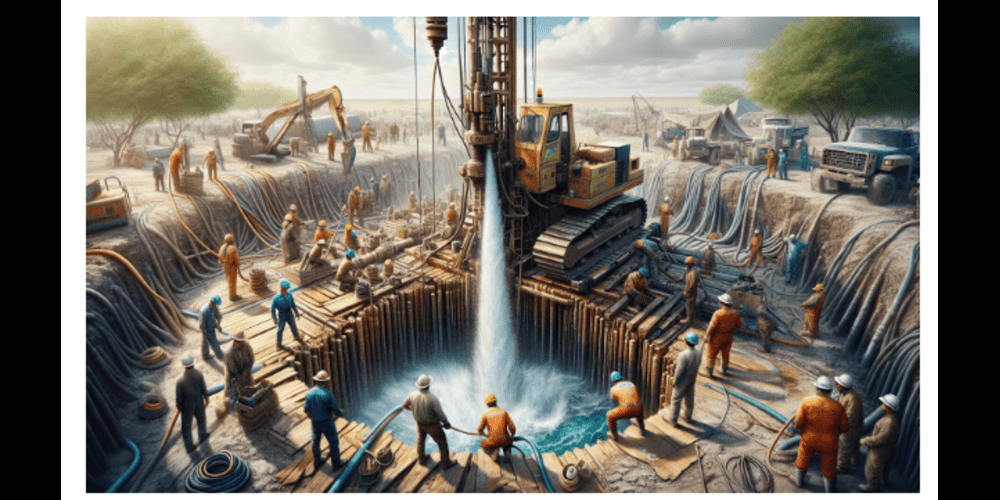The Evolution of Well Drilling Rigs for Modern Exploration

Introduction to Well Drilling Rigs
Definition and Purpose of Well Drilling Rigs
The essence of well drilling rigs lies in their purpose to penetrate the earth’s surface to extract fluids such as water, oil, or natural gas. A well drilling rig is a complex arrangement of machinery that is designed to bore holes deep into the subsurface. This apparatus is the cornerstone of many industries, supporting exploration for new resources and the exploitation of existing deposits. Modern rigs are marvels of engineering, capable of drilling to unprecedented depths with remarkable precision.
Historical Overview of Drilling Techniques
Throughout history, human innovation has driven the pursuit of resources deep within the earth. The earliest drilling methods were manual, requiring human or animal power to turn drilling apparatus. With time, these techniques evolved from simple hand-held augers and chisels to more complex mechanical contrivances. The development of steam power marked a significant leap in drilling capability, paving the way for the birth of the modern oil and gas industry. A thorough understanding of this evolution underscores the advancements that have led to the high-tech drilling operations we see today.
Early Drilling Rig Technologies
Manual Drilling Methods
In ancient China, workers utilised bamboo poles to drill for brine and natural gas, applying human force to reach the depths needed. Similarly, in the pre-industrial era, the simple yet labour-intensive spring pole was used for salt drilling in Europe. These methods required teams of workers and were limited in depth and efficiency. Despite their rudimentary nature, these early techniques set the foundation for the drill rigs of the future, showcasing humanity’s relentless pursuit of earth’s buried treasures.
The Advent of Mechanical Rigs
The industrial revolution brought about significant changes with the introduction of steam engines, which were quickly adapted to power drilling rigs. These mechanical rigs were not only faster but could also reach greater depths. As metal cables replaced manila ropes and iron bits overtook wooden counterparts, well drilling entered a new era of efficiency and capability. The standardisation of well components and the introduction of well control equipment marked the next leap in drilling technology.
The Revolution of Rotary Drilling
Development of Rotary Drilling Technique
The biggest breakthrough in drilling came with the development of rotary drilling in the late 19th century. This technique involves a rotating drill bit to cut through the earth, substantially speeding up the process and increasing the depths achievable. Coupled with the circulation of drilling fluid to remove cuttings and stabilise the hole, rotary drilling rigs transformed the entire industry. They made drilling quicker, safer, and more dependable—a far cry from the manual methods of the past.
Impact on Oil and Gas Exploration
Rotary drilling had a profound effect on the oil and gas exploration process, enabling the boom of the 20th century. The technique allowed for the exploitation of oil reserves that were previously considered unreachable. The newfound ability to drill wells quickly and to great depths catalysed the petroleum industry’s explosive growth, fueling global economies and advancements in technology. Rotary drilling remains the principal method of drilling for hydrocarbons today.
Advancements in Rig Mobility
From Permanent to Portable Rigs
The evolution of the well drilling rig saw a shift from stationary to mobile structures, enabling exploration in previously inaccessible areas. Portable rigs made it possible to explore remote locations, drilling numerous exploration wells efficiently. This mobility revolutionised the industry, as rigs could be transported and erected in new locations with relative ease compared to their predecessors.
Innovations in Transport and Setup
Advances in vehicular technology and logistics allowed for the creation of rigs that could be transported in pieces and assembled on-site. Innovations such as the modular rig design further reduced the time and cost of transport and setup, leading to increased agility in the field. Hydraulic systems and self-erecting rig features were later developments that streamlined the onsite assembly process, allowing rigs to switch locations with minimal downtime.
Offshore Drilling Developments
Transition from Land to Sea
As onshore resource deposits began to dwindle, the industry looked to the oceans for untapped reserves. The transition from land to sea posed numerous technological challenges. Initial offshore drilling efforts utilised piers and wooden platforms, but these were soon replaced by more robust and versatile steel structures designed to withstand the harsh maritime environment.
Platforms, Semi-Submersibles, and Drillships
Offshore rigs evolved to include fixed platforms, semi-submersibles, and drillships, all designed to adapt to a variety of oceanic conditions. Fixed platforms were suitable for shallow waters, while semi-submersibles, which could be precision-positioned and then anchored, were better for deeper waters. Drillships took this a step further, providing mobility and the ability to drill in extremely deep waters, with some capable of operating in depths of several thousand metres.
Enhancements in Drilling Precision
Directional and Horizontal Drilling
The advent of directional and horizontal drilling marked yet another turning point for the industry. Directional drilling allows the well path to be steered, while horizontal drilling enables the well to traverse long distances horizontally through the reservoir. These techniques significantly increased the productivity of wells by maximising contact with the resource-bearing formations and allowing for the drilling of multiple wells from a single location.
Real-time Data and Automation
In modern times, real-time data collection and automated systems have taken drilling precision to new heights. Sensors positioned throughout the rig and downhole tools provide continuous feedback on drilling conditions, allowing for immediate adjustments. Automation of drilling operations further enhances precision, with computer-controlled systems capable of executing complex drilling techniques with minimal human intervention.
The Rise of Eco-Friendly Drilling Practices
Reducing Environmental Impact
As environmental concerns take centre stage, the drilling industry has adapted by implementing practices aimed at minimising ecological impact. Reducing the footprint of drilling operations, protecting groundwater, and cutting down on emissions are at the forefront of eco-friendly drilling. Innovative technologies seek to address these issues by improving efficiency and reducing waste.
Use of Clean Technology in Drilling Operations
The integration of clean technology into drilling operations has been a significant step in mitigating environmental risks. This includes the use of biodegradable drilling fluids, advanced waste management systems, and the electrification of rig systems to reduce reliance on diesel. Furthermore, adherence to stringent environmental regulations and the development of ‘green’ drilling rigs reflect the shifting paradigm towards more sustainable drilling practices.
Modern Rig Safety and Reliability
Safety Measures and Protocols
The modern well drilling rig is subject to rigorous safety standards. Advanced monitoring systems, blowout preventers, and well-designed safety protocols are crucial to preventing accidents. Training in safe operation procedures and emergency response is regularly conducted to ensure the well-being of the crew and the environment. The integration of safety into every aspect of rig design and operation underscores the industry’s commitment to safe practices.
Technological Advances for Accident Prevention
Technology plays a vital role in enhancing the safety of drilling operations. Innovations such as remote-controlled drilling, early kick detection systems, and predictive maintenance software have substantially reduced the incidence of accidents. Safety systems are now more sophisticated, capable of not only responding to emergencies but also predicting and mitigating potential risks well in advance.
Artificial Intelligence and Robotics
The future of well drilling rigs is likely to be shaped by artificial intelligence (AI) and robotics. AI has the potential to revolutionise drilling by further improving efficiency, predicting equipment failures, and optimising resource recovery. Robotics may lead to fully-automated drilling rigs that can operate in harsh or dangerous environments with minimal human oversight, enhancing both safety and productivity.
Changing Energy Market and its Impact on Rig Technology
As the global energy market evolves, with a shift towards renewable resources and low-carbon solutions, rig technology must adapt accordingly. The decline in demand for fossil fuels could lead to a decrease in the number of rigs needed or a repurposing of existing rigs for different types of drilling, such as geothermal. Rig designs may need to become even more efficient and environmentally friendly to stay viable in a changing market.
Conclusion
The Transformation of Well Drilling Rigs
The transformation of well drilling from simple manual systems to complex, high-tech apparatus reflects the relentless push of human ingenuity and engineering prowess. Modern exploration would not be possible without these advanced rigs, which have made it possible to harness the planet’s natural resources to a degree once considered unimaginable.
Ongoing Challenges and Innovations in the Field
The well drilling rig will continue to be a focal point of innovation as technological advancements push the boundaries of what is possible in resource exploration. Ongoing challenges, such as environmental considerations and the need for even greater precision and safety, will drive the evolution of rig technology. As we look to the future, we can expect that well drilling rigs will remain at the forefront of the continuous quest for energy and resources.
Read More From Techbullion





